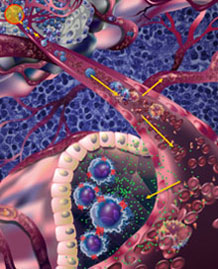

New Consortium Led by Scripps Research Scientists Awarded $10 Million by National Cancer Institute
By Mika Ono
The National Cancer Institute of the National Institutes of Health (NIH) has awarded a $10 million, five-year grant to a new physics oncology center led by Scripps Research Institute scientists.
Research at the center aims to achieve a better understanding of the behavior of cancer cells during metastasis, the spread of cancer from a primary tumor to other sites throughout the body. This understanding is directly aimed at determining more effective methods to manage cancer, a widespread health concern. According to the American Cancer Society, approximately 1.5 million new cases of cancer are diagnosed each year in the United States and cancer is responsible for about 23 percent of all deaths in this country, second only to heart disease.
"We are excited by the award," said Scripps Research Professor Peter Kuhn, who is the principal investigator of the grant. "We hope that by uniting an outstanding translational team of scientists and clinicians in different specialties we can make rapid headway in filling in the large gaps in our knowledge about the behavior of cancer cells that circulate in the bloodstream. We hope this information will ultimately help clinicians determine who should be receiving aggressive treatments and who should not, as well as laying the groundwork for the development of novel therapeutic approaches."
The grant was awarded under the first round of funding from a new signature initiative of the National Cancer Institute (http://physics.cancer.gov/). The initiative, conceptualized last year in a series of think tank meetings in Washington, D.C., creates a series of 12 Physical Sciences-Oncology Centers whose aim is to advance the understanding of the physical laws and principles that shape and govern the emergence and behavior of cancer.
"By bringing a fresh set of eyes to the study of cancer, these new centers have great potential to advance, and sometimes challenge, accepted theories about cancer and its supportive microenvironment," said National Cancer Institute Director John E. Niederhuber, M.D. "Physical scientists think in terms of time, space, pressure, heat, and evolution in ways that we hope will lead to new understandings of the multitude of forces that govern cancer—and with that understanding, we hope to develop new and innovative methods of arresting tumor growth and metastasis."
The Scripps Research-led consortium is dubbed the "4DB Center" after the project's full name, "Focusing on Four Dimensional Heterogeneity of Fluid Phase Biopsies in Cancer." The project brings together oncologists and pathologists at Scripps Clinic, the University of California, San Diego's Moores Cancer Center, and Billings Clinic (Montana) with physicists and biologists at Scripps Research, applied mathematicians and engineers at the Viterbi School of Engineering at the University of Southern California, and biomedical engineers at Oregon Health & Sciences University.
Together, the team hopes to generate a comprehensive portrait of cancer cells, including their numbers, physical properties, and gene expression profiles, as they act through space—in the patients' body—as well as time—over the course of the disease's progression.
The researchers will track two types of cancer cells: those from patients with colon cancer, which characteristically shows a slow clinical course, and those from patients with non-small cell lung cancer, which typically shows a more aggressive and rapid clinical course with greater differences in disease progression among individuals.
This will be the first time that such a study has been conducted. Until recently, the technology was not available to make these types of observations about cancer cells without frequent biopsies from patients. Advances in the field, however, now make it possible to analyze information from circulating tumor cells from simple blood samples collected from patients.
"Working directly with blood samples from cancer patients provides a direct link to the bedside," said Kuhn. "There is a rather long and depressing list of anti-cancer therapeutics that were tremendously successful in animal models but that failed to exhibit activity against cancer when tested in humans. Our ability to work with human blood samples should increase the relevance of our findings to those in need."
For more information on the 4DB Physical Sciences Oncology Center, see http://4db.us.
Send comments to: mikaono[at]scripps.edu

Researchers at the new physics oncology center aim to generate a comprehensive view of the dynamics of cancer cells during metastasis and disease progression. Click to enlarge.
